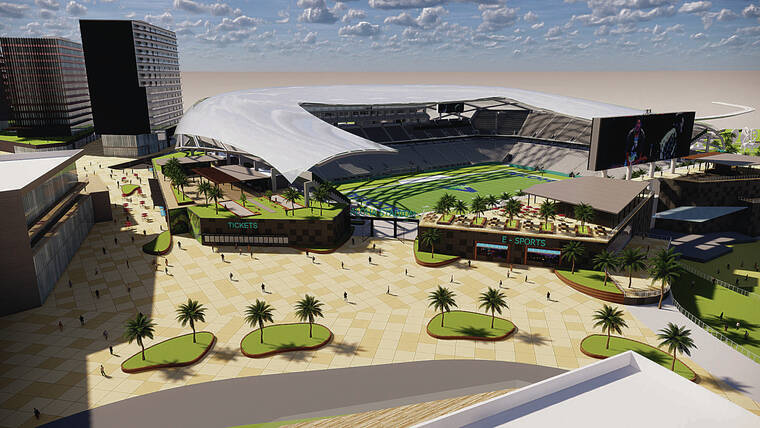It will be a head-to-head contest between a pair of
development partnerships seeking to turn 73 acres of state land around Aloha Stadium into a community with homes and businesses.
State officials Monday announced that two developer-led teams have qualified as finalists for the project in Halawa following a request for proposals in October.
The state Department of Accounting and General Services, which is leading the procurement process, received interest from 10 development teams but only two complete and compliant responses.
The finalist teams include developers, architects, construction companies, public relations firms and other consultants.
One finalist, Aloha Halawa District Partners, is led by New York-based Development Ventures Group Inc. and Honolulu-based Stanford Carr Development LLC.
Other members of this team are Hawaiian Dredging Construction Co., WATG, SB Architects, Rebound Associates, Colliers, Wilson Okamoto Corp., NBBJ LP, DTL and Bennet Group.
The other finalist, Waiola Mixed-Use Partners, is led by Honolulu-based Kobayashi Group and an
affiliate of Honolulu-based BlackSand Capital.
Other Waiola members are Machete Group Inc.,
Design Partners Inc., Manica Architecture, Stantec, Nan Inc., A.C. Kobayashi, JMA Ventures LLC, BAMP Project, Biederman Redevelopment Ventures, SSFM International, Wilson Okamoto Corp., Nainoa Thompson and S.H.A.D.E.
DAGS anticipates that one of the two developers will be selected by summer to carry out the project after submitting construction and technical details for an initial piece of the 73-acre site along with an overall concept for the entire property that could take around two decades or longer to complete.
Envisioned elements in what has been dubbed the New Aloha Stadium Entertainment District, or NASED, include high-rise housing, retail, restaurants, a hotel, offices and at least 4,000 parking spaces on the state-owned site next to a city rail station.
“The two developer-led teams represent decades of experience in Hawaii’s construction industry and have the proven ability to execute the vision for the NASED real estate project that has been shared with us by members of the community,” Chris Kinimaka, DAGS public works administrator, said in a statement. “We’ve heard from the community that NASED needs to be a true live-work-play-thrive entertainment district that will reinvigorate the area and become a beacon of community pride on game days and throughout the year.”
A winning team would be allowed to lease the 73 acres in increments for redevelopment. Lease payments to the state would help offset taxpayer costs to replace 47-year-old Aloha Stadium through a separate procurement process with other competing developers.
Replacing the existing 50,000-seat stadium is
estimated to cost around $400 million and occupy 25 acres of the 98-acre stadium property currently dominated by surface parking. A winning developer for this piece of NASED would build and maintain a new stadium with around 30,000 seats. The Stadium Authority, a state agency, would operate the new facility.
DAGS expects that
$350 million in state taxpayer financing will be available to help pay for the new stadium and possibly some of the surrounding real estate project, which will need costly infrastructure upgrades.
Originally, DAGS envisioned that one development partnership might produce a new stadium and a surrounding mixed-use community. But last year the agency separated NASED into two pieces after picking three finalists in late 2020 as qualified to take on the project in one piece.
The three finalists selected over a year ago are now eligible to compete for the stadium replacement work.
Another change in the original plan affected the use of Aloha Stadium and timetable for building a new facility.
DAGS initially expected that a new stadium would be finished in 2023 before demolishing the existing arena so as not to disrupt use by the University of
Hawaii football team, high school football teams, concert promoters and others.
However, the Stadium
Authority condemned the arena for spectator use after early coronavirus pandemic restrictions in 2020, which led UH to retrofit its practice field in Manoa to host games in 2021 and in upcoming
seasons.
Construction of a new stadium in Halawa is now expected to begin in 2023 after DAGS seeks proposals from the three teams eligible for the stadium replacement and makes an award by the end of this year.
One of the three teams
eligible for the stadium replacement includes several partners in one of the two teams selected to compete for the real estate portion of NASED.
Kobayashi Group, the BlackSand Capital affiliate BSC Acquisitions II LLC, Design Partners, Manica Architecture and Nan are part of a team called Waiola Development Partners eligible for the stadium replacement work. Other members of this team are EllisDon Capital Inc., Turner Construction Co. and Spectra.
The two other teams eligible for the stadium replacement work are Aloha Sta-
dium District Partners and Aloha Stadium Hui Hilina‘i.
Aloha Stadium District Partners was formed by John Laing Investments Ltd., Civil &Building North America Inc., Hawaiian Dredging, NBBJ Hawaii Inc., RMA Architects, Aramark Management Services LP and Honeywell International Inc.
Aloha Stadium Hui Hilina‘i was formed by Plenary Americas US Holdings Inc., PCL Investments Canada Inc., M. Arthur Gensler Jr. &Associates Inc., KYA Inc., Nordic PCL Construction and Johnson Controls Inc.




